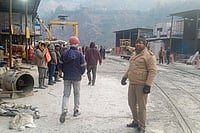India’s commercial real estate sector is undergoing a transformative phase, with office leasing across major cities experiencing an unprecedented surge in recent months. As of June 2025, office space absorption across six major cities reached 38.2 million sq.ft., a 7% year-on-year rise, according to Savills India. This robust activity is complemented by a 44% jump in new office supply, which stood at 25.3 mn. sq.ft. during H1 2025. With vacancy rates tightening to 14.7% and India’s Grade A office stock reaching 822.9 mn. sq.ft., the story today isn’t about recovery, it’s about a rapid, structural transformation in how India works and grows.
A Defining Phase of Growth
Anshuman Magazine, chairman & CEO - India, South-East Asia, Middle East & Africa, CBRE, sees this moment as pivotal. “India's office sector has entered a defining phase of growth, with leasing activity in H1 2025 touching an all-time high of 39 mn. sq.ft. — a testament to the country's growing stature as a global business hub.” He points to the expansion of technology firms, BFSI institutions, and flexible space operators as key drivers, adding that Global Capability Centres (GCCs) have leased over 15 mn. sq.ft., underscoring India’s rising importance in global operations.
Economic Resilience and Sectoral Depth
Supporting this view, Peush Jain, MD - commercial leasing & advisory, Anarock Group, attributes the strong performance to India’s economic robustness. “Both net absorption and new office completions saw high growth – 40% and 25% respectively – largely because of India's enduring economic strength,” he notes. The optimism isn’t misplaced; even amid global uncertainty, India's GDP growth forecasts remain among the highest worldwide, making it an attractive bet for multinationals.
Dr. Niranjan Hiranandani, chairman, NAREDCO, echoes this sentiment, emphasising India’s expanding knowledge economy. “Gross absorption touched approximately 26.6 mn. sq.ft., with Bengaluru, Hyderabad, and Pune leading the momentum,” he states. Sectoral diversification is becoming a hallmark, with engineering and manufacturing contributing 21% and BFSI 14% of the leasing share. Flex spaces too are gaining ground, accounting for nearly 15% of all transactions.
“Both net absorption and new office completions saw high growth – 40% and 25% respectively – largely because of India's enduring economic strength.”Peush Jain, MD - Commercial Leasing & Advisory, Anarock Group
The Flex Space Phenomenon
The co-working and managed office segment has seen a notable upswing. “The positive trend is visible in startup investments, which marginally increased in 2024, helping drive demand for quality office spaces,” says Shesh Rao Paplikar, founder & CEO, BHIVE Workspace. He highlights how both startups and large enterprises are embracing flexible workspaces in line with their expansion strategies.
Mukul Pasricha, founder & CEO, Spring House Workspaces, adds that inquiries for flexible offices have surged over 30%, driven by a growing emphasis on hybrid work, wellness, and experiential design. Similarly, Rahul Sarin, co-founder & CEO, FlexLeaze, notes, “The demand for enterprise-grade flexible workspaces is reshaping how companies approach their real estate footprint.”
“High-quality Grade A office supply, mature tech infrastructure, and hybrid-friendly workspaces have made Indian metros attractive to both multinational firms and growing domestic enterprises.”Bijay Agarwal, Managing Director, Sattva Group
Infrastructure and Innovation Drive Momentum
According to Ashish Raheja, MD & CEO, Raheja Universal, cities like MMR, Bengaluru, Delhi-NCR, Hyderabad, and Pune are leading the surge due to infrastructure growth and global supply chain realignments. “There’s a clear shift towards integrated business hubs — developments that combine work, lifestyle, and wellness,” he says, citing Raheja District in Navi Mumbai as a flagship example.
In Mumbai, this infrastructure-driven momentum is tangible. “Seamless access enabled by the metro, coastal road, and the trans harbour link has significantly enhanced the appeal of well-connected locations,” says Vikas Jain, CEO, Labdhi Lifestyle Limited. From Bandra-Kurla Complex (BKC) to the upcoming Dharavi Redevelopment, Mumbai is entering a new growth cycle anchored in design, connectivity, and quality.
The Rise of Tier-2 Cities
What distinguishes the current surge is its geographic spread. “India’s office leasing momentum is no longer confined to metros, it’s cascading into tier-2 cities like Indore,” observes Manoj Dhanotiya, founder & CEO, Micro Mitti. With rental yields of 6–7% and annual appreciation of upto 15% in prime areas, Indore is attracting GCCs, IT-BPM players, and flex space operators. Dhanotiya emphasises the city’s cost advantage, 30–40% lower than Bengaluru or Pune, making it a magnet for scalable growth.
Rajat Mehta, co-founder & director, ElitePro Infra, underlines this decentralisation trend. “We’re seeing increasing interest in tier-2 cities as part of a strategic and cost-effective market expansion.” He notes that the shift toward flexible, scalable office spaces is deeply tied to changing business needs, hybrid work adoption, and rising demand for employee-centric environments.
“India's rapid GCC growth is cementing its status as a global innovation hub, with gross leasing expected to cross 90 mn. sq.ft. in 2025.”Binitha Dalal, Founder & Managing Partner, Mt. K Kapital
Delhi-NCR: The Powerhouse
Delhi-NCR is emerging as a leasing powerhouse, according to Payas Agarwal, director, Great Value Realty. The region recorded a gross leasing volume of 4.6 million sq. ft. in Q2 2025, a 68% QoQ increase. Gurugram led the charge, contributing 70% of this, driven largely by GCCs and domestic enterprises. “Nearly two-thirds of the transactions involved fresh space take-up, indicating expansionary intent,” he points out. The rise in average rentals (2–4% QoQ) and tightening vacancy levels suggest sustained demand momentum.
Ashish Sharma, AVP – operations, Brahma Group, reinforces this view: “India’s office leasing is being reshaped by strong domestic demand, hybrid work, and GCC growth. Since 2022, homegrown firms have driven nearly half of all leasing, showing deep economic confidence. Among all markets, Delhi-NCR leads with robust infrastructure, excellent connectivity, and a diverse occupier base — and is poised to stay ahead with strong supply and investor interest.”
A Broader Global Repositioning
India's prominence in global innovation and operational strategy is also influencing office space trends. “The fast growth of GCCs has turned the country into a key hub for global innovation,” says Binitha Dalal, founder and managing partner, Mt. K Kapital. She projects gross leasing to surpass 90 mn. sq.ft. in 2025, driven by GCCs, domestic enterprises, and flexible workspaces.
“Among all markets, Delhi-NCR leads with robust infrastructure, excellent connectivity, and a diverse occupier base — and is poised to stay ahead with strong supply and investor interest.”Ashish Sharma, AVP – Operations, Brahma Group
Looking Ahead
As noted by Gaurav Mavi, co-founder, BOP.in, leasing activity stood at 77.2 mn. sq.ft. in 2024, with the first quarter of 2025 already recording 15.9 mn. sq.ft., a YoY growth of 15%. “This increase looks not just like a recovery in demand, but a new re-imagination of space related to businesses' needs following the pandemic,” he states. Co-working and GCCs together accounted for more than 40% of leasing in 2024, revealing a strong pivot toward flexibility and innovation.
Bijay Agarwal, managing director, Sattva Group, underscores the macro trends fuelling this growth. “This strong leasing momentum reflects the ongoing transformation of Indian cities into strategic business hubs. High-quality Grade A office supply, mature tech infrastructure, and hybrid-friendly workspaces have made Indian metros attractive to both multinational firms and growing domestic enterprises. The convergence of skilled talent availability, robust infrastructure, and cost competitiveness continues to position India's office markets as a preferred destination for global expansion.”
Aman Sharma, MD & founder, Aarize Group, sums up the new reality: “Corporates are increasingly prioritising quality, sustainability, and employee-centric workspaces. This trend underlines confidence in India’s long-term business potential and urban commercial growth.”
“Flexible workspaces continue to gain traction, driven by rising startup investments in 2024 and a growing demand for scalable office solutions.”Shesh Rao Paplikar, Founder & CEO, BHIVE Workspace
Conclusion
India’s office leasing boom is more than just a post-pandemic rebound. It is a deep-seated transformation powered by economic resilience, structural demand, global strategic shifts, and a redefinition of what the modern workplace means. From Bengaluru to Indore, from flex space to built-to-suit campuses, from startups to global MNCs, the landscape is dynamic, decentralised, and future-facing. The commercial real estate sector is no longer playing catch-up with economic growth, it’s setting the pace.



























